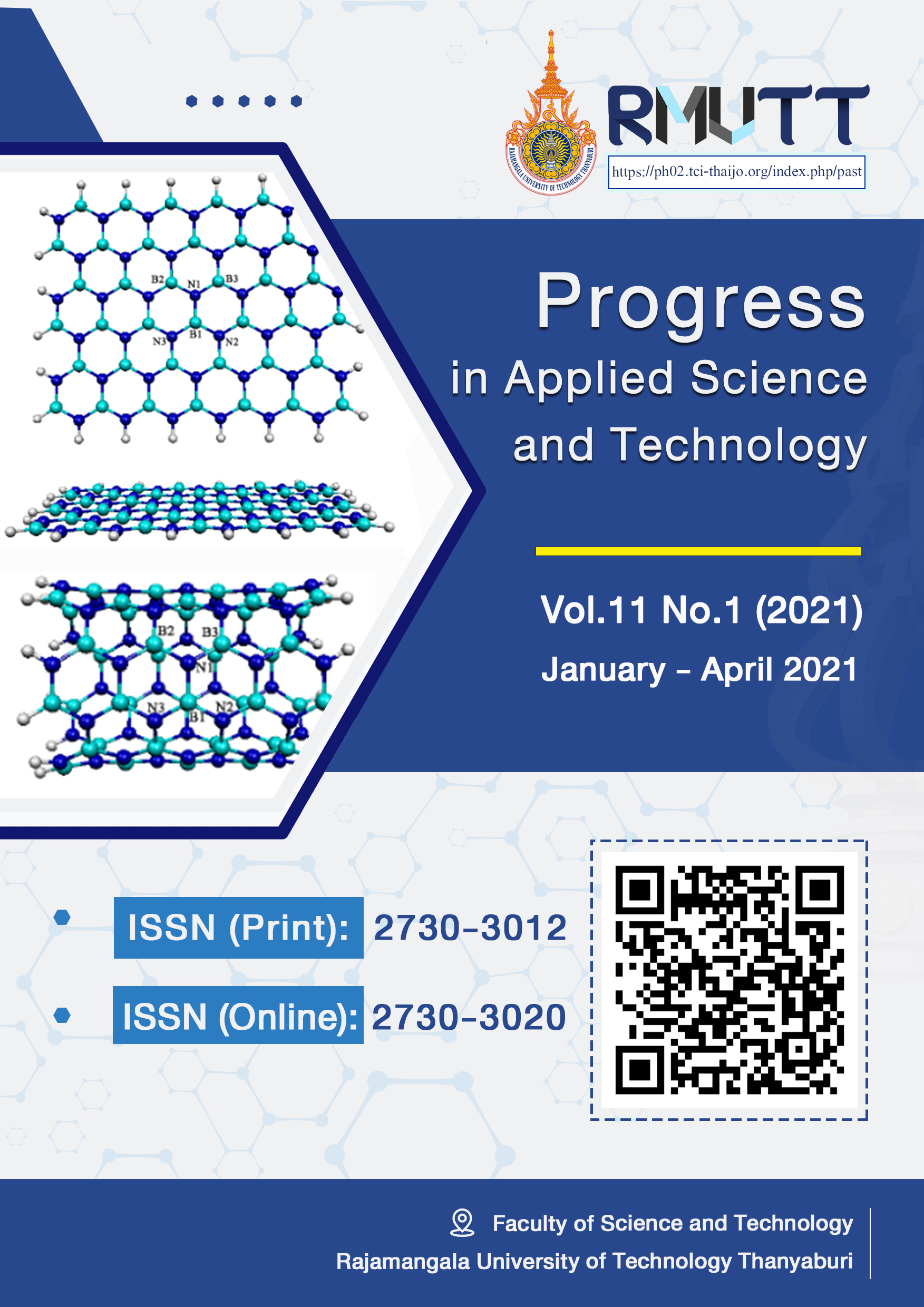Fabrication of pH-Sensing Sodium Alginate Films Containing Clitoria Ternatea Linn. Extract and Drug Release Characteristics
Main Article Content
Abstract
Halochromic property of the sodium alginate films containing Clitoria ternatea Linn. flower extract (SA/CT) was studied. Gallic acid (GA) with pKa of 4.4 and resorcinol (RC) with pKa of 9.3 as the model drugs were loaded into the SA/CT films, and their halochromic behaviors were investigated. The color change of the films was influent by the pH of solutions and pKa of drugs. The release profiles of either GA or RC from the films were determined by the total immersion and transdermal diffusion through pig skin method at 37°C for 24 h in three types of media, including an acetate buffer (pH 5), a phosphate buffer (pH 7), and a borax buffer (pH 9) solutions. For the total immersion method, the burst release of drugs at the initial time of release followed by the gradual release until reaching a plateau was observed. The maximum cumulative amounts of drug release were in a range of about 17-29%. The amounts of drug release depended on the pH of the solutions and the pKa of drugs. The more polar molecules exhibited higher amounts of drug release. The slower release and the lower maximum cumulative amounts of drug release in a range of 5-21% were obtained for the transdermal diffusion method. Like the total immersion method, the amounts of drug release depended on the solutions' pH and the pKa of drugs. However, the less polar molecules exhibited higher amounts of drug release.
Article Details

This work is licensed under a Creative Commons Attribution-NonCommercial-NoDerivatives 4.0 International License.
References
Schneider LA, Korber A, Grabbe S, Dissemond J. Influence of pH on wound-healing: A new perspective for wound-therapy? Arch Dermatol Res. 2007;298(9):413–20.
Intuyod K, Priprem A, Limphirat W, Charoensuk L, Pinlaor P, Pairojkul C, et al. Anti-inflammatory and anti-periductal fibrosis effects of an anthocyanin complex in Opisthorchis viverrini-infected hamsters. Food Chem Toxicol. 2014;74:206–15.
Siti Azima AM, Noriham A, Manshoor N. Phenolics, antioxidants and color properties of aqueous pigmented plant extracts: Ardisia colorata var. elliptica, Clitoria ternatea, Garcinia mangostana and Syzygium cumini. J Funct Foods. 2017;38:232–41.
Escher GB, Wen M, Zhang L, Deliberali N. Phenolic composition by UHPLC-Q-TOF-MS/MS and stability of anthocyanins from Clitoria ternatea L. (butterfly pea) blue petals. Food Chem. 2020;127341.
Chen S, Wu M, Lu P, Gao L, Yan S, Wang S. Development of pH indicator and antimicrobial cellulose nanofibre packaging film based on purple sweet potato anthocyanin and oregano essential oil. Int J Biol Macromol. 2020;149:271–80.
Ma Y, Ding S, Fei Y, Liu G, Jang H, Fang J. Antimicrobial activity of anthocyanins and catechins against foodborne pathogens Escherichia coli and Salmonella. Food Control. 2019;106(March):106712.
Oguis GK, Gilding EK, Jackson MA, Craik DJ. Butterfly pea (Clitoria ternatea), a cyclotide-bearing plant with applications in agriculture and medicine. Front Plant Sci. 2019;10(May):1–23.
Rawdkuen S, Faseha A, Benjakul S, Kaewprachu P. Application of anthocyanin as a color indicator in gelatin films. Food Biosci. 2020;36(February 2018):100603.
Murillo-Álvarez JI, Hernández-Carmona G. Monomer composition and sequence of sodium alginate extracted at pilot plant scale from three commercially important seaweeds from Mexico. J Appl Phycol. 2007;19(5):545–8.
Rubio-Elizalde I, Bernáldez-Sarabia J, Moreno-Ulloa A, Vilanova C, Juárez P, Licea-Navarro A, et al. Scaffolds based on alginate-PEG methyl ether methacrylate-Moringa oleifera-Aloe vera for wound healing applications. Carbohyd Polym. 2019;206(3918):455–67.
Abbasi AR, Sohail M, Minhas MU, Khaliq T, Kousar M, Khan S, et al. Bioinspired sodium alginate based thermosensitive hydrogel membranes for accelerated wound healing. Int J Biol Macromol. 2020;155:751–65.
Montaser AS, Rehan M, El-Naggar ME. pH-Thermosensitive hydrogel based on polyvinyl alcohol/sodium alginate/N-isopropyl acrylamide composite for treating re-infected wounds. Int J Biol Macromol. 2019;124:1016–24.
Tang Y, Lan X, Liang C, Zhong Z, Xie R, Zhou Y, et al. Honey loaded alginate/PVA nanofibrous membrane as potential bioactive wound dressing. Carbohyd Polym. 2019;219(March):113–20.
Surveswaran S, Cai YZ, Corke H, Sun M. Systematic evaluation of natural phenolic antioxidants from 133 Indian medicinal plants. Food Chem. 2007;102(3):938–53.
Wutticharoenmongkol P, Hannirojram P, Nuthong P. Gallic acid-loaded electrospun cellulose acetate nanofibers as potential wound dressing materials. Polym Advan Technol. 2019;30(4):1135–47.
Karimi-Khouzani O, Heidarian E, Amini SA. Anti-inflammatory and ameliorative effects of gallic acid on fluoxetine-induced oxidative stress and liver damage in rats. Pharmacol Rep. 2017;69(4):830–5.
Díaz-Gómez R, López-Solís R, Obreque-Slier E, Toledo-Araya H. Comparative antibacterial effect of gallic acid and catechin against Helicobacter pylori. LWT-Food Sci Technol. 2013;54(2):331–5.
Rivera AE. Acne scarring: A review and current treatment modalities. J Am Acad Dermatol. 2008;59(4):659–76.
Hiasa M, Kurokawa M, Ohta K, Esumi T, Akita H, Niki K, et al. Identification and purification of resorcinol, an antioxidant specific to Awa-ban (pickled and anaerobically fermented) tea. Food Res Int. 2013;54(1):72–80.
Chuysinuan P, Thanyacharoen T, Techasakul S, Ummartyotin S. Electrospun characteristics of gallic acid-loaded poly vinyl alcohol fibers: Release characteristics and antioxidant properties. J Sci Adv Mater Devices. 2018;3(2):175–80.
Thitiwongsawet P, Wichapeng N, Waiyaroj A. Electrospun polycaprolactone fiber mats as carriers for tannic acid. Adv Mater Res. 2014;19(4):37–44.
National Institutes of Health. Dissociation constant of gallic acid. Available from: https://pubchem.ncbi.nlm.nih.gov/compound/370#section=Dissociation-Constants (accessed 18 June 2020).
National Institutes of Health. Dissociation constant of resorcinol. Available from: https://pubchem.ncbi.nlm.nih.gov/compound/5054#section=Dissociation-Constants (accessed 18 June 2020).
Dodero A, Pianella L, Vicini S, Alloisio M, Ottonelli M, Castellano M. Alginate-based hydrogels prepared via ionic gelation: An experimental design approach to predict the crosslinking degree. Eur Polym J. 2019;118:586–94.
Bruice PY. Essential Organic Chemistry: International Edition. 2nd ed: Pearson Education: United States; 2006.
Uchida Y. Chapter 41 - Skin Lipids. Cosmet Sci Tech. 2017;685–698.
Gupta R, Badhe Y, Rai B, Mitragotri S. Molecular mechanism of the skin permeation enhancing effect of ethanol: A molecular dynamics study. RSC Adv. 2020;10(21):12234–48.
Karimi AR, Tarighatjoo M, Nikravesh G. 1,3,5-Triazine-2,4,6-tribenzaldehyde derivative as a new crosslinking agent for synthesis of pH-thermo dual responsive chitosan hydrogels and their nanocomposites: Swelling properties and drug release behavior. Int J Biol Macromol. 2017;105:1088–95.
Robert CCR, Buri PA, Peppas NA. Influence of the drug solubility and dissolution medium on the release from poly(2-hydroxyethylmethacrylate) microspheres. J Control Release. 1987;5(2):151–7.






